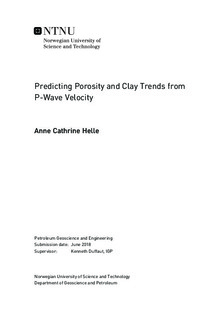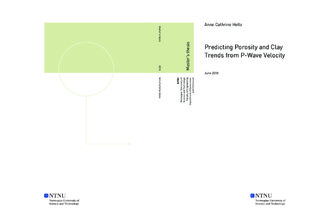| dc.description.abstract | P-waves are sensitive for several parameters, and when P-waves are the only information present, the primary effects have to be identified. In this study, two models are created to describe the relation between porosity, clay content, and P-wave velocity. The models are constructed by taking base in a sand-clay mixture undergoing mechanical compaction, where the transition from the grain-supported regime to the matrix-supported regime is described. The aim of the study is to investigate if it is possible to predict porosity and clay content solely based on P-wave velocities.
The two models are based on Dvorkin's Textural Sorting and the Bound Averaging Method. The Dvorkin model uses the difference in grain sizes to create a porosity model, and the elastic moduli are calculated by using Hertz-Mindlin and Hashin-Shtrikman. The modified Bound Averaging Method model takes base in the Voigt and Reuss bounds, and an anisotropic elastic constant is introduced. In this model, an iso-stress analogue for the Reuss, $w$, is used to account for changes in stress. The models are compared to lab data and are used to perform porosity and clay content estimations in three wells from the Norwegian Continental Shelf. The sand-clay mixture is assumed to be fully water-saturated and is modeled for different net stresses. The porosity and clay content estimations are carried out by assuming both a hydrostatic case and an overpressured case in the wells.
Both models underpredict the porosity in the transition between the grain-supported regime to the matrix-supported regime when tested on lab data. The velocities are also overpredicted in the transition between the two constituents, where the Dvorkin model yields a stiffer result than the modified Bound Averaging Method model, overestimating the velocities to be $7.5 - 24.2$ \% higher relative to the lab data.
When using sonic velocities to predict porosity and clay trends in the wells, the findings show that both models are able to capture the general porosity and clay trends. The models are, however, shown to have difficulty to accurately predict porosity and clay trends in the transition between the grain-supported regime and the matrix-supported regime, where the general trend is an underprediction of porosity, and both an under- and overprediction of clay content. The modified Bound Averaging Method yields better results when more information is available to estimate $w$, while the Dvorkin model yields better results when information in scarce. The models offer a simple way to conceptualize and explain the complex relation between porosity, clay content, and P-wave velocity. | |

